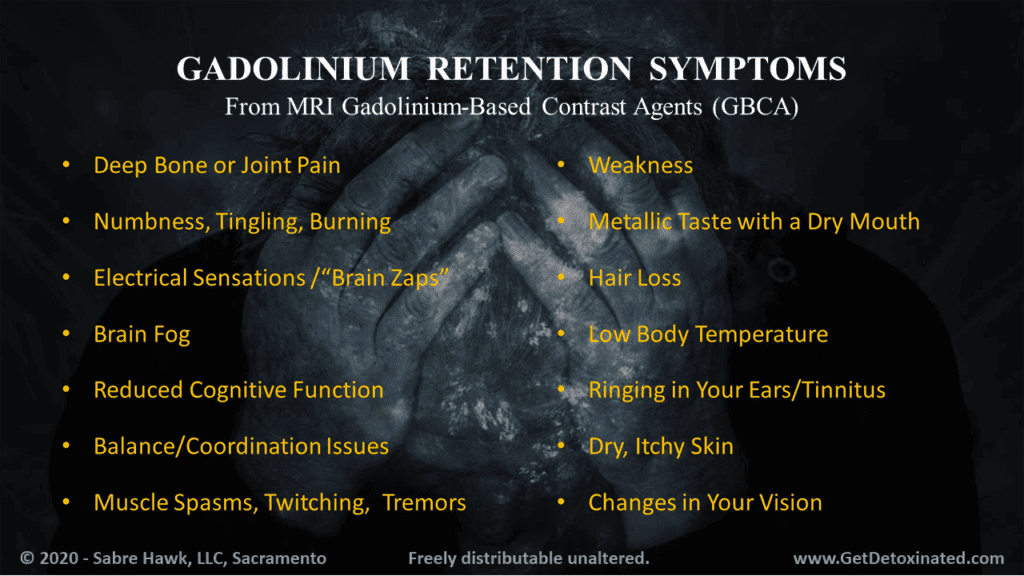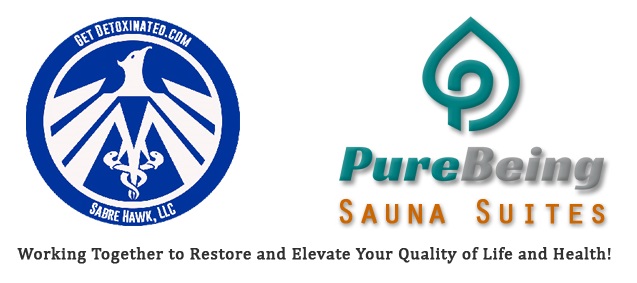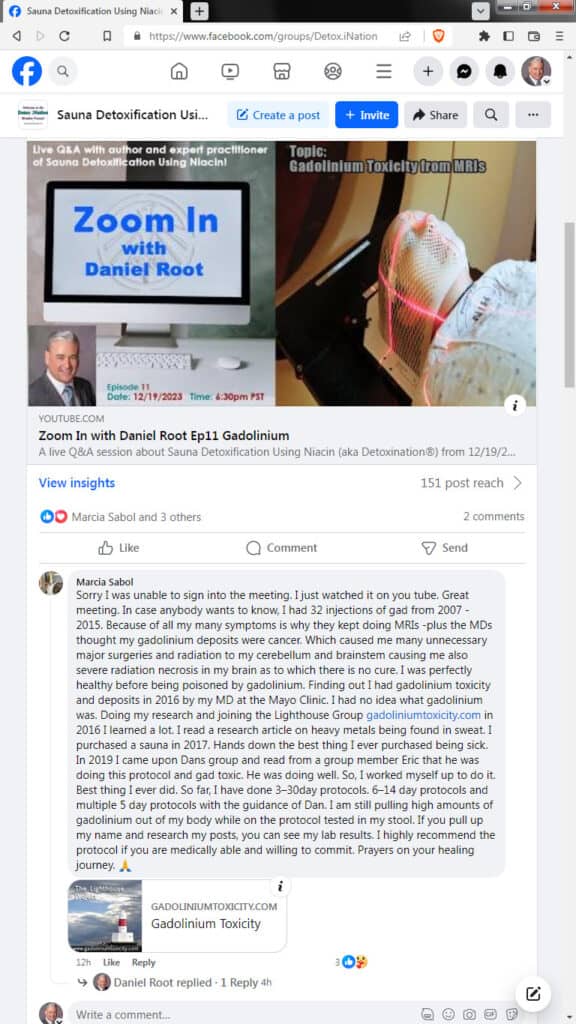MRI – Magnetic Resonance Insanity: Toxic Gadolinium
“My highest priority is daily pain and the twisting/squeezing tightness of craniofacial tendons and ligaments. The skin on my scalp feels like an open, gaping wound at the slightest touch. The neuropathy and not having a sense of where my arms and hands are, is just as painful.”
These horrific statements are from a respondent to a survey conducted in 2014 of patients that underwent anywhere from 1 to 8 Magnetic Resonance Imaging tests using a now-controversial intravenous Gadolinium-Based Contrast Agent (GBCA) to enhance images of abnormal tissue. GBCAs are generally thought to be safe to use; however, retention of gadolinium in fat, bone, and brain tissue is known to have serious consequences.
Researchers have estimated that approximately 1% (15 mg) of the 1.5 grams of injected gadolinium from each dose of contrast (0.1 mmol/kg body weight) may be released from the contrast agent and deposited in the bones of GBCA exposed patients including those with normal kidney function.
Gadolinium is neurotoxic. It inhibits mitochondrial function and induces oxidative stress. The Blood-Brain Barrier is easily disrupted, and this is why gadolinium is deposited in brain tumors and brain lesions such as those seen in Multiple Sclerosis.
Symptoms of gadolinium poisoning include pain in the arms and legs, bone pain, tissue burning and brain fog. The medical community and government agencies have recognized the toxicity of retained gadolinium from GBCAs as the primary contributor to the development of Nephrogenic Systemic Fibrosis (NSF) in patients with compromised renal function.
NSF may resemble skin diseases, such as scleroderma and scleromyxedema, with thickening and darkening developing on large areas of the skin, according to the Mayo Clinic. It can also affect internal organs, such as the heart, kidneys and lungs, and it can cause a disabling shortening of muscles and tendons in the joints (joint contracture).
NSF can begin days to months after exposure to gadolinium-containing contrast, but progresses quickly. Some signs and symptoms of nephrogenic systemic fibrosis may include:
- Swelling and tightening of the skin
- Thickening and hardening of the skin, typically on the arms and legs and sometimes on the body, but almost never on the face or head
- Skin that may feel “woody” and develop an orange-peel appearance and darkening (excess pigmentation)
- Burning, itching or severe sharp pains in areas of involvement
- Skin thickening that inhibits movement, resulting in loss of joint flexibility
- Rarely, blisters or ulcers
In some people, involvement of muscles and body organs
- Muscle weakness
- Limitation of joint motion caused by muscle tightening (contractures) in arms, hands, legs and feet
- Bone pain (usually severe)
- Reduced internal organ function, including heart, lung, diaphragm, gastrointestinal tract, or liver, but direct evidence is often lacking
- Yellow plaques on the white surface (sclera) of the eyes
- Blood clots

Of the 17 patients cited in the study, “pain” was identified as a chronic symptom, along with burning, numbness, tingling, or prickling sensations (aka Paresthesia). Also identified by 10 patients were “deep bone pain” and “electric-like feelings.” This study indicates that gadolinium, a rare earth heavy metal, can be retained in tissues for 79 months (6.5 years) or more.
Patients who underwent multiple MRIs are at even greater risk of bioaccumulating gadolinium, even with normal functioning kidneys. Unfortunately, the onset of their symptoms may take weeks to appear, so the MRI connection isn’t immediately apparent. In the study, 100% of the patients experienced symptoms within the first month following contrast MRI, and 59% reported their symptoms almost immediately.
There have been many class action lawsuits filed since 2016 to stop the insanity of gadolinium use, as MRIs and MRAs (magnetic resonance angiography) can be performed without this toxic element. However, these cases are routinely dismissed as long as GBCA administration falls under the “Standard of Care” guidelines.
Tests are available to determine urine levels of Gadolinium; however, these can only reveal a small fraction of the accumulated burden. And, in the case of urine or stool samples, the tests only reveal what elements assayed are being eliminated.
The good news for MRI/Gadolinium victims is that sauna detoxification can reduce the body burden of this, and other xenobiotics (foreign substances to the body, like heavy metals, synthetic chemicals, and Persistent Organic Pollutants). Subjective Symptom Surveys by our patients, taken before and again 30 days post-treatment, indicate a 78-100% improvement in their symptoms.
The effectiveness of this protocol is not just theoretical. Take the case of Marcia Sabol, who endured 32 GBCAs, leaving her bedridden and disabled. After discovering our Detoxination Protocol, Marcia experienced a significant turnaround in her health, highlighting the protocol’s potential in heavy metal detoxification.
If you or a loved one has suffered from Gadolinium toxicity, our Detoxination Protocol using sauna, exercise, and niacin (vitamin B3) can help prevent or reverse long-term health issues. To learn more about Detoxination, please browse this website or contact us TODAY!
 Click here to learn more about our Testimonials and Results Disclaimer
Click here to learn more about our Testimonials and Results Disclaimer
Disclaimer: Information on this web site is provided for informational purposes only. The information is a result of years of practice experience by the authors. This information is not intended as a substitute for the advice provided by your physician or other healthcare professional or any information contained on or in any product label or packaging. Do not use the information on this web site for diagnosing or treating a health problem or disease, or prescribing medication or other treatment. Always speak with your physician or other healthcare professional before taking any medication or nutritional, herbal or homeopathic supplement, or using any treatment for a health problem. If you have or suspect that you have a medical problem, contact your health care provider promptly. Do not disregard professional medical advice or delay in seeking professional advice because of something you have read on this web site. Information provided on this web site and the use of any products or services purchased from our web site by you DOES NOT create a doctor-patient relationship between you and any of the physicians affiliated with our web site. Information and statements regarding dietary supplements have not been evaluated by the Food and Drug Administration and are not intended to diagnose, treat, cure, or prevent any disease.



You must be logged in to post a comment.